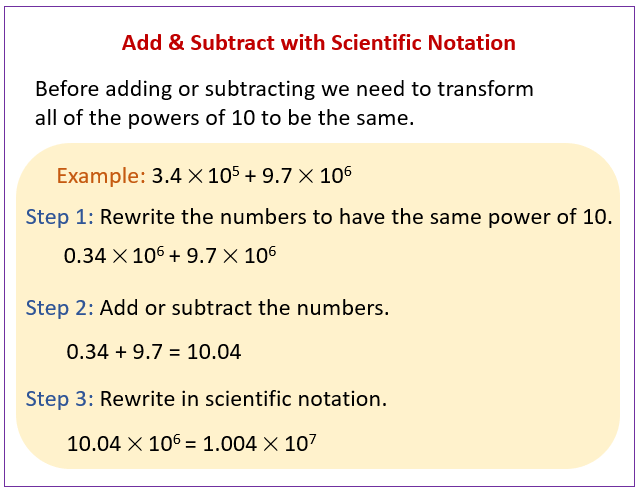Adding Or Subtracting Numbers In Scientific Notation
Related Pages
Converting Scientific Notation
Multiplying Scientific Notation
Dividing Scientific Notation
In this lesson, we will look at some examples of adding and subtracting numbers in scientific notation (Scientific notation is called standard form in the UK.)
A number is in scientific notation when it is in the form
A × 10n where
- 1 ≤ |A| < 10. This part is called the significand or mantissa.
- n is an integer. This part is the exponent or power of 10.
To add or subtract numbers in scientific notation, the exponents must be the same. If they are different, you must adjust one (or both) numbers to match before performing the operation.
Scientific Notation: Addition And Subtraction
The following diagram shows how to add or subtract numbers in scientific notation. Scroll down the page for more examples on adding and subtracting with scientific notation.

Scientific Notation Worksheets/Games:
Practice your skills with the following scientific notation worksheets:
Online & Printable Scientific Notation Worksheets
| Scientific Notation Games | ||
|---|---|---|
| Scientific Notation Converter | Add/Subtract Scientific Notation | Scientific Notation Multiplication |
| Scientific Notation Division | ||
Steps to add or subtract numbers in scientific notation
Before you can add or subtract the significands, the exponents of 10 must be the same. To do this, you might need to adjust one or both numbers.
To add or subtract two numbers in scientific notation:
Step 1: Adjust the powers of 10 in the 2 numbers so that they have the same index.
(Tip: It is easier to adjust the smaller exponent to equal the larger exponent).
If you move the decimal point to the left, increase the exponent by the number of places moved.
If you move the decimal point to the right, decrease the exponent by the number of places moved.
Step 2: Add or subtract the significands.
Once the powers of ten are the same, you can add or subtract the significands. Treat the 10n part as a common factor.
a × 10n + b × 10n = (a + b) × 10n
a × 10n - b × 10n = (a - b) × 10n
Step 3: Adjust the Result to Proper Scientific Notation (if necessary)
The result from Step 2 might not be in proper scientific notation. If necessary, adjust the decimal point in the significand and change the exponent accordingly:
If the significand is less than 1: Move the decimal point to the right until it is between 1 and less than 10, and decrease the exponent by the number of places moved.
If the significand is 10 or greater: Move the decimal point to the left until it is between 1 and less than 10, and increase the exponent by the number of places moved.
Example:
Evaluate 2 × 103 + 3.6 × 104, giving your answer in
scientific notation.
Solution:

Example:
Evaluate 7 × 105 – 5.2 × 104, giving your answer in
scientific notation.
Solution:

Add And Subtract Numbers In Scientific Notation With Same Or Different Exponents And Negative Exponents
This video explains how to add and subtract numbers written in scientific notation, whether or not they have the same exponent.
Examples:
(3.769 × 105) + (4.21 × 105)
(8.14 × 10-2) - (2.01 × 10-2)
(7.58 × 105) + (2.871 × 106)
(2.9785 × 10-8) - (5.72 × 10-10)
(4.86 × 103) - (4.72 × 103)
Why You Have To Make Sure The Exponents Are The Same?
This video explains why when adding and subtracting numbers in scientific notation, you have to make sure the exponents are the same.
Example:
(7.1 × 103) + (5 × 102)
Rules For Scientific Notation
This video reviews scientific notation and shows how to add and subtract in Scientific Notation.
Rule for scientific notation:
- If the exponent goes down, the decimal point goes right.
- If the decimal point goes right, the exponent goes down.
- If the exponent goes up, the decimal goes left.
- If the decimal point goes left, the exponent goes up.
Scientific Notation - Addition And Subtraction Rules
This video explains how to do add and subtract in scientific notation without the use of a calculator.
- The powers of 10 must be the same in both terms in order to add/subtract.
- Once the power of 10 matches, just add or subtract.
- Adjust the answer to scientific notation.
Scientific Notation - Adding And Subtracting
Learn how to add and subtract in scientific notation.
Add and subtract numbers in different bases by rewriting their exponents to be the same.
Example:
(3.5 × 104) + (3.1 × 105)
Try out our new and fun Fraction Concoction Game.
Add and subtract fractions to make exciting fraction concoctions following a recipe. There are four levels of difficulty: Easy, medium, hard and insane. Practice the basics of fraction addition and subtraction or challenge yourself with the insane level.

We welcome your feedback, comments and questions about this site or page. Please submit your feedback or enquiries via our Feedback page.